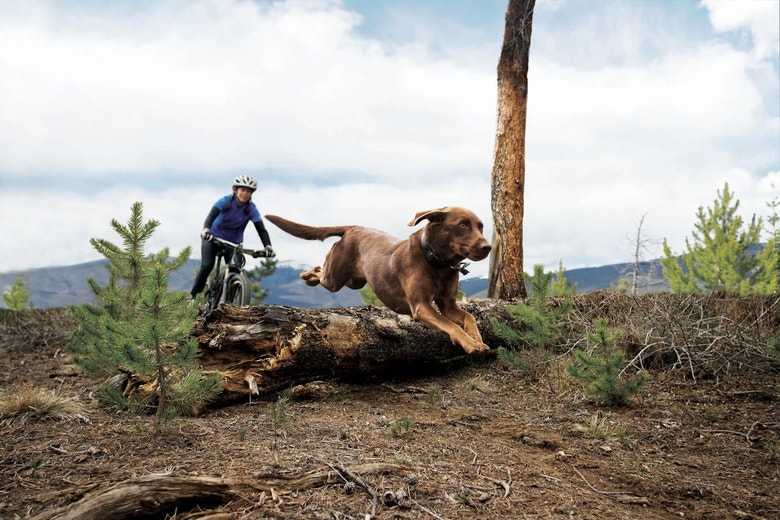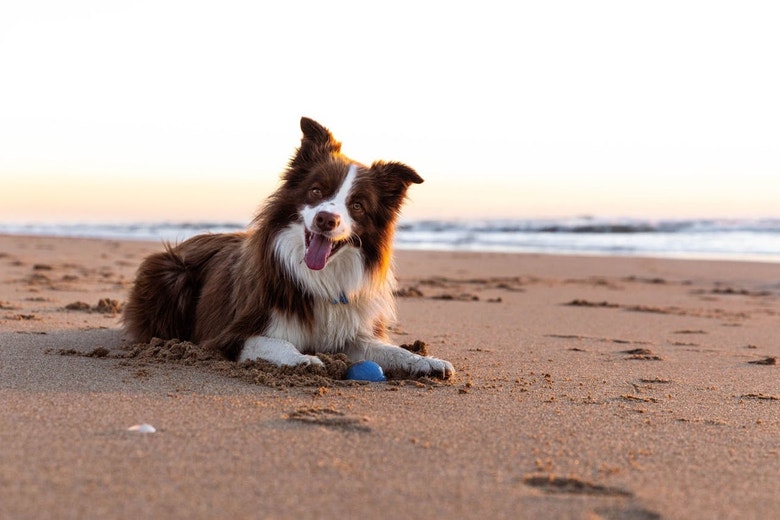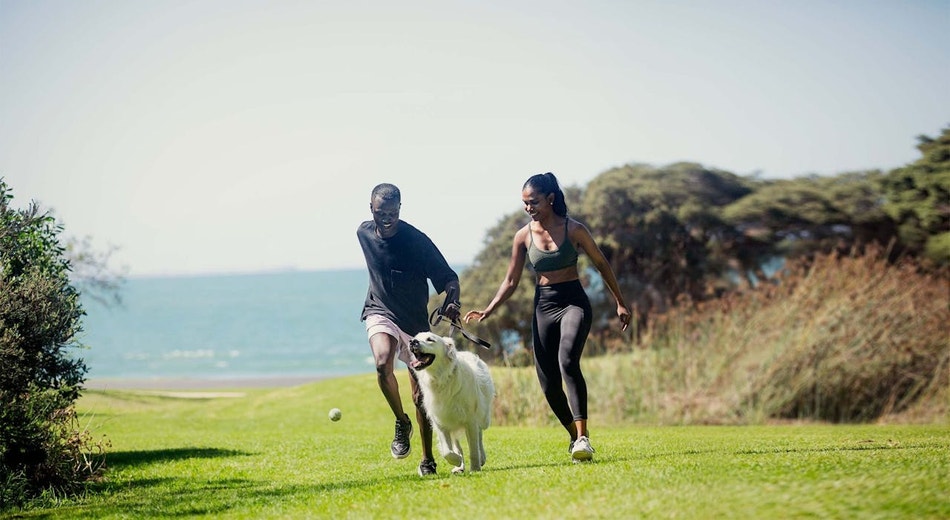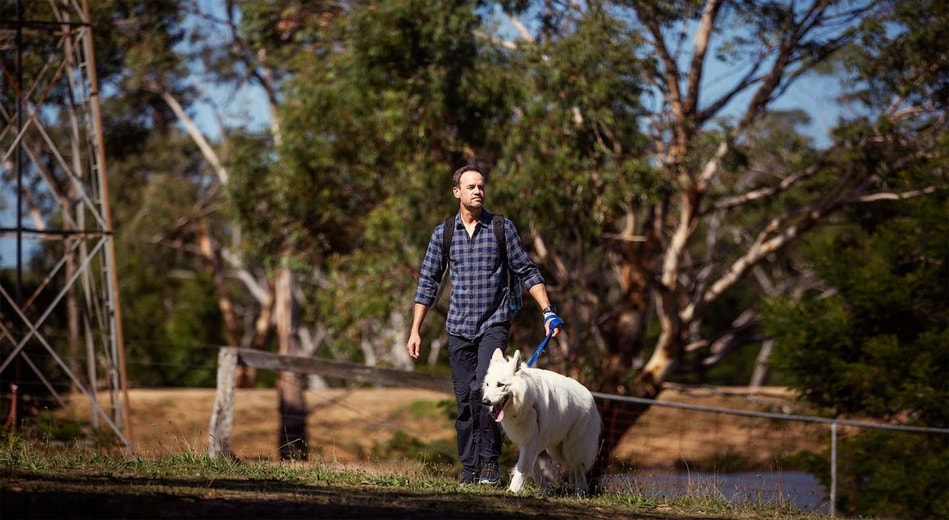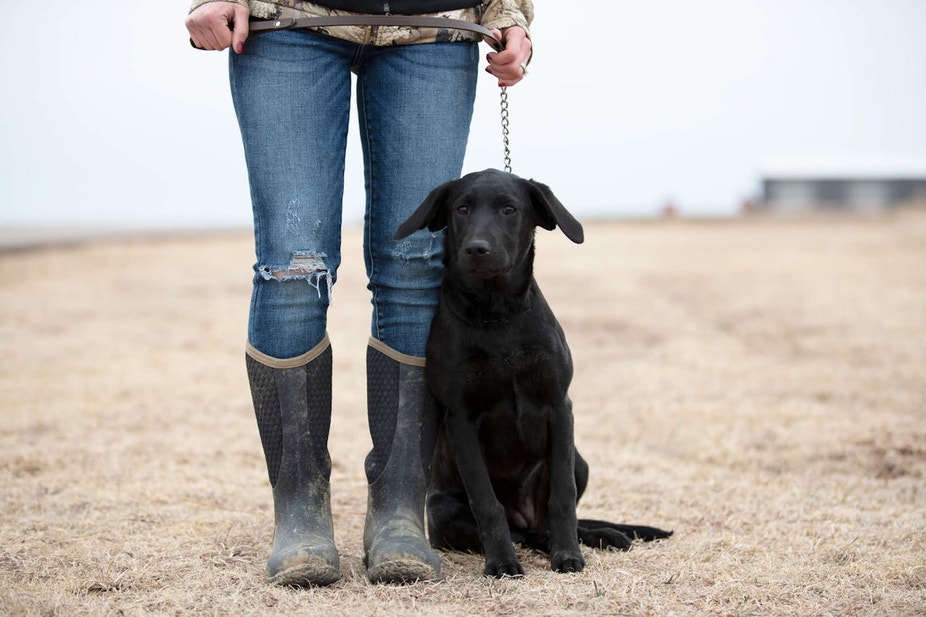
A Guide To Teaching Your Puppy To Walk On A Leash
Walking on a leash is an essential skill which can be learned by puppies as early as eight weeks old. Some master leash training quickly, while others take a little longer. Either way, it’s important to remain consistent, positive – and above all, patient.
While it’s often thought that puppies instinctively know how to walk beside their owner on a leash, this isn’t the case. In fact, leash training can be confusing for a puppy. As they’re not used to the restriction of a collar, harness or leash, they’ll need an adjustment period before they can be expected to calmly walk beside you without pulling on the leash.
This article teaches you the fundamentals of training your puppy to walk on a leash, including:
- Why is leash training important?
- When should you start training your puppy to walk on a leash?
- Essential leash training equipment for your puppy
- The step-by-step process for puppy leash training
- Common leash training problems and solutions
- How to stop your puppy barking at other dogs on a walk
- When should you start training your puppy to walk on a leash?
- How to train your puppy to walk beside you
- What if your puppy doesn’t want to go for a walk?
WHY IS LEASH TRAINING IMPORTANT?
Leash training builds a puppy’s trust and boosts their confidence. It also allows dog owners to expose their puppies to new environments, creating positive behavior around training sessions by establishing important boundaries.
Puppies who haven’t been taught to walk on a leash often develop one of two habits. Some become anxious when taken for walks, as they’re fearful of their new environments, noises, and obstacles (people, other dogs). Others start to ‘act out’ by becoming aggressive and overexcited during walks, making it difficult for their owner to regain control
WHEN SHOULD YOU START TRAINING YOUR PUPPY TO WALK ON A LEASH?
Puppies can learn simple commands from eight weeks old, including leash training. As soon as you’ve brought your puppy home and begun training, it’s safe to introduce a leash/harness. However, we strongly recommend fully vaccinating your puppy before venturing outside on a leash.
We’re not suggesting your puppy should be taken for long walks as soon as they’re vaccinated – quite the opposite. You’ll need to introduce exercise in short bursts, increasing slowly over time. This will allow your puppy to develop confidence while reducing the risk of injury.
It’s vital, though, for your puppy to get used to the idea of walking beside you, wearing a collar, and learning that you’re in charge right from the beginning. Teaching these skills is the best way to prevent them from forming undesirable behaviors.
LEASH TRAINING ESSENTIALS FOR YOUR PUPPY
Where puppies are concerned, it pays to be prepared – and leash training is no different.
Here is some leash training equipment to accelerate your puppy’s learning process:
- Leash
- Collar and harness
- Treats
- Barriers – including crates, pet pens, and or playpens. (These can help create a simple route when you’re training your puppy inside your home.)
- Longline leash (for when your puppy gains confidence)
- Patience (and a lot of positive reinforcement).
THE STEP BY STEP PROCESS FOR PUPPY LEASH TRAINING
Teaching a puppy to walk calmly by your side means there’s no need for pulling … on either end of the leash. Instead, your puppy will learn to walk beside you within the leash’s length, creating a much smoother, more enjoyable process for you both.
Keep reading to discover our step-by-step process for teaching a puppy to walk calmly beside you while on a leash:
(1) INTRODUCE YOUR PUPPY TO THEIR NEW LEASH/HARNESS
First, allow time for your puppy to get acquainted with their new collar/harness and lead. (It’s best to start indoors, as there’s less stimulation to distract your puppy.)
Don’t rush. Give your puppy time to sniff around their new leash/harness, while offering ample positive reinforcement. Once their interest wanes, fasten the harness and allow them ample time to get used to it.
(2) TEACH YOUR PUPPY A NEW COMMAND
Once your puppy grows comfortable with the harness around their body, introduce a command (such as ‘come’) to encourage them to walk towards you while wearing it. As soon as they do, reward them with a treat and plenty of positive reinforcement.
(3) ENCOURAGE YOUR PUPPY TO COME TO YOU
Continue moving around the room, beckoning your puppy to move towards you. Prepare to reward them as soon as they’ve done what you’ve asked. Repeat this process several times to make sure they fully understand, before calling it quits for the day,
You may find this process slow, basic, and even a little frustrating, but don’t worry – there’s a good reason for taking a leisurely pace. Puppies have short attention spans, and often lose interest during training. To avoid delaying your puppy’s development, it’s important to remain calm without losing patience.
(4) WALK YOUR PUPPY AROUND THE ROOM ON A LEASH
Once your puppy has mastered wearing a harness, it’s time to introduce the leash. Gently attach your puppy’s leash to their collar, while continuing to offer plenty of positive reinforcement and treats.
It’s common for a puppy to pull away when first introduced to the leash. If this happens, don’t attempt to stop them. Instead, keep your puppy in eyesight as they drag the lead around the room, which helps them become accustomed to a loose leash. It’s important to give your puppy enough time to get used to their leash and feel comfortable with their new accessories.
When teaching your puppy to walk on a leash, the real trick is to avoid dragging or forcing them into walking beside you, or going where you want to go. Instead, let them get used to the feeling of the leash. If they become overexcited and try to pull, wait for them to calm down before moving forward. They’ll soon learn that no pressure on the leash means ‘go’, while slight pressure means ‘stop’
(5) TAKE YOUR TRAINING OUTSIDE
When you’ve mastered these steps, it’s time to start training your puppy outside.
The outside world holds plenty of distractions for your puppy, so it’s important to train in a low-distraction area (your backyard, for example). Practice walking forward just a few steps, asking for your puppy’s attention as you slowly advance. The training process will remain fairly straightforward, although you’ll have to grapple with a couple of other distractions as your puppy encounters the great outdoors. (More on these below.)
COMMON LEASH TRAINING PROBLEMS & THEIR SOLUTIONS
A walk with your puppy can be enjoyable or a bit of a battle – sometimes both in the same walk! It’s your responsibility to foster a more relaxed, controlled walking style. Once you understand why your puppy’s showing signs of undesirable behavior, you can redirect them to a more constructive behavior that allows you to walk more freely.
Here are three common leash problems – and effective ways to deal with them
PUPPY PULLING ON THE LEASH
Pulling is a natural response for a puppy, as it allows them to reach their destination at their own pace. (They’re doing this not to display dominance, but simply because it works!)
When out walking with your puppy, make sure you’re aware of your body position. If you’re idling a few steps behind them while allowing them to take the lead, they’ll begin feeling as though they’re ‘in charge’ and start tugging at the lead to pull you along.
To prevent this, here are several methods for training your puppy to stop pulling on the leash.
PLAY THE REWARD GAME
One of the easiest and most effective ways to teach your puppy to walk on a leash beside you is to reward them each time they pay attention to you and perform your desired action (walking on a leash by your side, at your pace).
Encourage your puppy to follow you
Hold the leash, then move away from your puppy by taking several steps backward. This action encourages your puppy to follow you. As soon as they approach, reward them with a treat and plenty of encouragement.
ENCOURAGE YOUR PUPPY TO FOLLOW YOU
If you’re having trouble training your puppy, it’s a good idea to create a short neighborhood route that you walk repeatedly. A familiar walk reduces distractions for your puppy, who will find it considerably less stimulating to walk a familiar route than to explore a new place each time.
BURN OFF EXTRA ENERGY IN ADVANCE
Puppies have a lot of excess energy, which they need to expend somehow. If you take them for a walk without burning it off beforehand, they may pull extra hard on their leash. Including an additional exercise session before their walk will help combat this problem.
Important note: While leash pulling is often seen as a problem of older dogs, it’s still common among puppies – so don’t be alarmed if this happens.
PUPPY BITING ON THE LEASH
The easiest, most effective way to stop your puppy from biting their leash is to quickly redirect their behavior. Puppy teething may occur more frequently during leash training, as they get used to the unnatural sensation of having their body restricted. Puppies often run around and wreak havoc until they’ve burnt off excess energy, when they abruptly decide to nap. A leash restricts this natural behavior, which may initially make your puppy seem more stubborn.
As we’ll see, redirection is one of the most important aspects of raising a puppy. While it can be used across various training sessions, it’s particularly useful during leash training.:
DON’T PULL ON THE LEASH
As we mentioned earlier, tugging on your puppy’s leash reinforces their desire to bite and pull it, as it seems fun and rewarding. Refrain from doing this, even though it’s tempting.
PROVIDE YOUR PUPPY WITH A TOY
Remember how we mentioned redirection as a key training method? This is where your puppy’s favorite toy comes into play. Once you’ve stopped your puppy from biting the leash, shift their focus by replacing it with their favorite toy. By doing this, you’ll redirect their chewing/biting behavior to a more productive area.
USE FOOD TO REWARD AND REDIRECT YOUR PUPPY
Alternatively, once your puppy has let go of the leash, refocus their attention by enticing them with their favorite food. Once they know you’re carrying some tasty treats, they’ll be laser-focused on you, not the leash!
PUPPY ACTING AGGRESSIVELY WHEN ON THE LEASH
Although leash aggression is more often associated with older dogs, it’s also important to train puppies to be calm from the outset to prevent this behavior from developing in the first place.
Dogs often act aggressively on a leash because they feel restrained, frustrated, and uncomfortable in a social situation. A puppy who’s feeling vulnerable and unprotected while on a leash may act out aggressively.
It’s important to understand that a leash-aggressive puppy isn’t ‘bad’ or ‘mean’. Instead, they’re often likely to be scared, which means punishment may worsen the behavior. You may wish to discuss leash aggression problems with your veterinarian, a veterinary behaviorist, or a trainer recommended by your veterinarian. In the meantime, avoid the stressful situation and refrain from negative reinforcement.
COMMON SIGNS FOR FEAR AGGRESSION
The easiest way to deal with aggression is by recognising the warning signs before anything can occur. As we mentioned earlier, aggression is often associated with your dog feeling fearful or stressed and likely feel trapped. Body language that may be displayed when your puppy’s feeling aggressive is as follows:
Lunging
Posturing
Direct eye contact
Pricked ears
Teeth exposed
If your puppy is displaying any of these behaviors, calmly remove them from the situation and redirect their attention with treats or a toy. Stay calm, as your puppy will pick up on (and become distressed by) your negative energy whenever you’re anxious.
Training your puppy to walk on a leash can be tricky at first, but it’s a valuable lesson that will create a new and fun way to bond with them. If you have any doubts, consider booking in a few training classes with your local animal behaviorist.
HOW TO STOP YOUR PUPPY BARKING AT OTHER DOGS ON A WALK
If your puppy’s stressed, they may begin barking at other dogs when out walking. So, if they’re barking at another dog, what should you do?
STAY CALM
Remember, your puppy isn’t always barking at other dogs for fun. They’re often likely to be barking because they’re nervous. If this is the case, make sure you’re not anxious about your puppy’s behavior. Stay calm and in control, without raising your voice excessively or rushing your puppy.
OFFER A TREAT
Then, as soon as they see a dog approaching, immediately give them a treat before they have time to bark. This will encourage them to associate calmness with rewards, making it easier for them to see other dogs without becoming overly excited.
If your puppy is simply too excited by other dogs to focus on anything at all, it may simply be a case of ‘too much, too soon’. Let’s look at how to remedy this.
REDUCE EXPOSURE
This could involve simply varying your route, so they aren’t exposed to as many other dogs. Alternatively, try walking your puppy at less busy times. (This could be a useful strategy early in your puppy’s walking career, before they’re ready for proper encounters.)
STEP UP THE PACE AGAIN
Once your puppy feels more confident walking on a leash, gradually increase their exposure to other dogs – making sure they don’t get too close (and excited). By keeping a safe distance, then gradually allowing your puppy to get a little closer to other dogs in subsequent walks, you’ll help steadily dampen their excitement levels.
HOW TO TRAIN YOUR PUPPY TO WALK BESIDE YOU
Walking your puppy when they’re straining at the leash or dragging their feet can be frustrating. For that reason, teaching your puppy to keep up with you on a walk is highly rewarding.
To find out how to train a dog to walk on a leash beside you, read on...
An unintrusive way of teaching your puppy to walk next to you is to use a clicker, reinforced by treats. This is best started when you’re inside your home, which is a controlled and low-stress environment.
WALK, CLICK, AND TREAT
Begin walking away from your puppy, and wait for them to catch up to you. As soon as they’re level with you, click the clicker and give them a treat straight away. (It has to be instant, so the connection between clicker and treat is crystal-clear.)
REPEAT THE PROCESS
Then, begin walking forward again. As your puppy will often be very energetic, they may run off ahead of you excitedly. If that happens, simply continue walking at your own pace and wait for them to return to you – then repeat the clicker/treat as soon as they stop trying to race ahead.
MOVE OUTSIDE
Once you’ve mastered this inside your home, choose a short well-known route nearby. Repeat the procedure above, walking back and forth between your home and a predetermined point. Don’t try a new route until your puppy has become comfortable walking beside you on this small, familiar circuit.
EXPAND THE WALK
Once you’re confident that your puppy’s understood, gradually lengthen your walk (perhaps around the block – not too far). Again, make sure they’ve got the right idea before further expanding your path.
So, if you’ve been wondering how to get your dog to walk beside you, now you know!
WHAT IF YOUR PUPPY DOESN’T WANT TO GO FOR A WALK?
Even though puppies are usually incredibly eager to go for a walk, sometimes they simply won’t want to come along. If your puppy doesn’t want to walk, there are several options you could try:
- It’s possible that your puppy doesn’t like being led on the leash. (This is quite common when they’re still getting used to it.) If this happens, have a supply of treats handy. Take them for a little walk inside your home first, then reward them when they come with you. As they gradually become bolder, venture a little further. (Your backyard’s ideal, if you have one; otherwise, try the nature strip or a very small grassy area.)
- Begin a ‘mini walk’ that’s 100% guided by you. To do this, try carrying your puppy to the other side of the street, then walking home together. Once that mental barrier’s been broken, your puppy’s likely to quickly get a taste for even more walking.
- Make sure every walk with your puppy is the best it can be. If they have a wonderful time from the word go, they’ll be far more eager to repeat the experience.
- There’s plenty you can do to help make the walk enjoyable, too. For example, don’t make your puppy’s walk too long or rush them during toilet breaks, and let them explore at will (when appropriate).
- Remember, a walk is their special time – you’re just along for the ride!
By taking this confident yet compassionate approach to leash training, you’ll be sure to have a walkable puppy on your hands in no time. Happy adventuring!
Eukanuba has formulated a puppy food range with high levels of DHA (Docosahexaenoic Acid), which has been shown to significantly improve focus and trainability. Find out more here(open in new tab).

